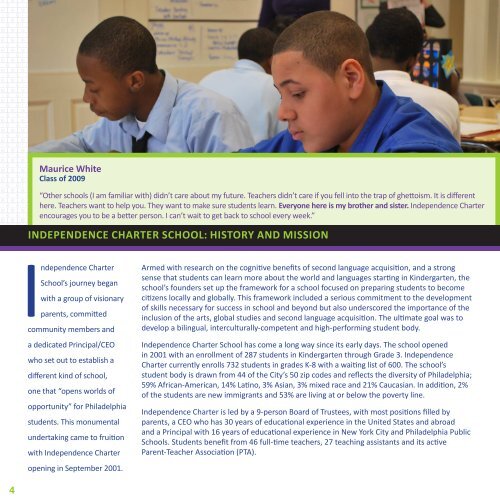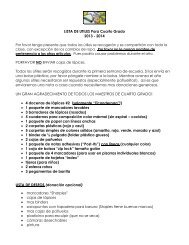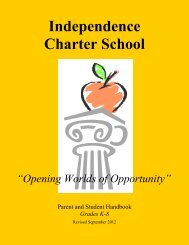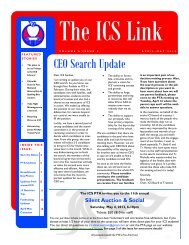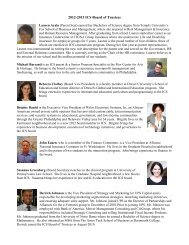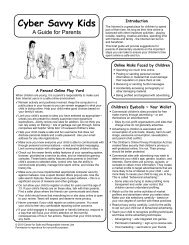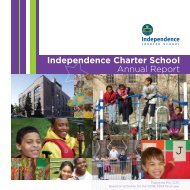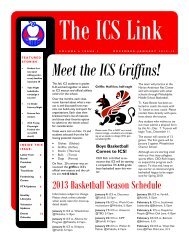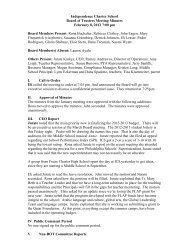Independence Charter School Annual Report
Independence Charter School Annual Report
Independence Charter School Annual Report
Create successful ePaper yourself
Turn your PDF publications into a flip-book with our unique Google optimized e-Paper software.
Maurice WhiteClass of 2009“Other schools (I am familiar with) didn’t care about my future. Teachers didn’t care if you fell into the trap of ghettoism. It is differenthere. Teachers want to help you. They want to make sure students learn. Everyone here is my brother and sister. <strong>Independence</strong> <strong>Charter</strong>encourages you to be a better person. I can’t wait to get back to school every week.”<strong>Independence</strong> <strong>Charter</strong> <strong>School</strong>: History and MissionBrittany PembletonClass of 2009“You can talk to the teachers. It feels like a home. It’s different from my friends’ schools. During my eight years here, I have had theopportunity to do a lot of different things. <strong>Independence</strong> <strong>Charter</strong> provides a gateway to where you want to go-the freedom to trynew things”.What makes <strong>Independence</strong> <strong>Charter</strong> Unique?<strong>Independence</strong> <strong>Charter</strong><strong>School</strong>’s journey beganwith a group of visionaryparents, committedcommunity members anda dedicated Principal/CEOwho set out to establish adifferent kind of school,one that “opens worlds ofopportunity” for Philadelphiastudents. This monumentalundertaking came to fruitionwith <strong>Independence</strong> <strong>Charter</strong>opening in September 2001.Armed with research on the cognitive benefits of second language acquisition, and a strongsense that students can learn more about the world and languages starting in Kindergarten, theschool’s founders set up the framework for a school focused on preparing students to becomecitizens locally and globally. This framework included a serious commitment to the developmentof skills necessary for success in school and beyond but also underscored the importance of theinclusion of the arts, global studies and second language acquisition. The ultimate goal was todevelop a bilingual, interculturally-competent and high-performing student body.<strong>Independence</strong> <strong>Charter</strong> <strong>School</strong> has come a long way since its early days. The school openedin 2001 with an enrollment of 287 students in Kindergarten through Grade 3. <strong>Independence</strong><strong>Charter</strong> currently enrolls 732 students in grades K-8 with a waiting list of 600. The school’sstudent body is drawn from 44 of the City’s 50 zip codes and reflects the diversity of Philadelphia;59% African-American, 14% Latino, 3% Asian, 3% mixed race and 21% Caucasian. In addition, 2%of the students are new immigrants and 53% are living at or below the poverty line.<strong>Independence</strong> <strong>Charter</strong> is led by a 9-person Board of Trustees, with most positions filled byparents, a CEO who has 30 years of educational experience in the United States and abroadand a Principal with 16 years of educational experience in New York City and Philadelphia Public<strong>School</strong>s. Students benefit from 46 full-time teachers, 27 teaching assistants and its activeParent-Teacher Association (PTA).Urban Education That Works<strong>Independence</strong> <strong>Charter</strong> is a leader among Philadelphia publicand private schools for its effective and innovative educationalprograms. <strong>Independence</strong> <strong>Charter</strong> stands out from the crowdfor the following reasons:1) Global Education Curriculum• A study of nations, cultural groups, histories and globalissues integrated into standards-based instruction acrossall subject areas.• The curricular experience of each student includesregular participation in the arts: dance/movement,music and the fine arts related to country andhistorical studies.2) Second Language Learning• Intensive Spanish instruction in all grade levels• Introduction to Japanese in grade 6 (2007-2009)and Swahili in 2009-2010• Introduction to Arabic in grade 7• Introduction to Chinese in grade 83) Learning Beyond the Classroom• A year-long National History Day Project with theNational Constitution Center• Marine life study at the Wetlands Institute in Stone Harbor• An annual National Geographic Bee• An annual Scripps Spelling Bee• Offsite cultural experiences including plays, concertsand museum visits• An annual International Festival• After school clubs such as Italian language, Geography,Chess Club, Freedom Writers and Odyssey of the Mind4) Parent InvolvementThe school’s parent community plays a central role in thesuccess of the school, with more than 39% of parentscontributing to its daily operations by:• serving on the <strong>School</strong>’s Board• participating in the PTA• volunteering as classroom helpers• organizing special events such as the KABOOMplayground build4 5


